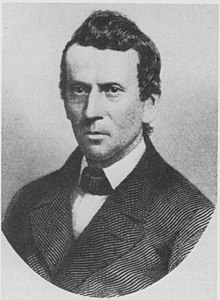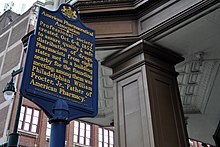118:
489:
502:
30:
495:
109:
160:
graduating in 1837. In 1844, he opened a shop of his own. Rather than a soda fountain, his shop included a laboratory and a writing area where he wrote scientific papers, practical articles, and editorials. He investigated a series of volatile oils. He experimented with new methods and apparatus.
226:
Procter became professor of practical and theoretical pharmacy at the college in 1846. He believed apprenticeships were the best way to train pharmacists. Lectures were held for apprentices in the evening from
October through February. His lectures covered pharmacy techniques such as maceration,
211:
from 1824. Procter served as editor until 1870. He added abstracts of articles published in
Britain and France. The Civil War stressed the finances of the journal as Southerners stopped subscribing. Trimming costs by reducing the number of pages and financial assistance from the college helped
187:
In the 1850s companies began to manufacture drug preparations that previously were prepared by hand by druggists. Concerns arose that commercial preparations could deviate from those in the
Pharmacopeia causing variations in effects. The government imposed excise taxes on alcohol during the Civil
151:
Procter worked in a time when pharmacy was an unregulated, unrestricted profession. Drug sales are open to anyone. Jobbers supplied the drug kits. Drugs were sold by general stores, by physicians, or by almost anyone with no training required. In addition to drugs, drug stores sold a variety of
175:
of the United States was created to establish standards for drug quality. The first edition was published in 1820. Procter participated in the 1840 revision of the
Pharmacopeia. Later the committee hired him as a consultant. The faculty of the Philadelphia College of Pharmacy assisted. The
227:
percolation and distillation followed by a discussion of drugs and preparations. He continued at the college for almost 20 years, resigning in 1866. He returned to the position in 1872 after the death of Edward
Parrish. Procter died in 1874 shortly after completing a lecture at the college.
170:
Assay of drugs became a specialty. Wholesalers paid for analysis before accepting a shipment. Imported drug materials could vary widely in quality. Drugs rejected in Europe were sometimes shipped to
America. Unethical vendors extended their wares by adding inerts like sawdust. The
188:
War. Alcohol was commonly used in preparations. Higher costs favored manufactured drugs. Licenses required for medicinal alcohol caused pharmacies to add liquor sales. Customers for liquor also bought tobacco products.
155:
Procter entered the field through an apprenticeship with Henry M. Zollickoffer in 1831 in
Philadelphia. Elias Durand, a nearby pharmacist trained in France, encouraged Procter to pursue investigations. He attended the
273:
undertook the opposite approach in 1867. Working through the Alumni
Association, the College set up a practical pharmacy laboratory in 1870. It was well accepted and became part of the College in 1872.
288:, who manufactured drugs in Brooklyn, NY. He was well respected in the pharmaceutical industry for his commitment to quality. He was a friend of Procter and participated in numerous discussions.
117:
269:
The transition from apprenticeships to training in schools of pharmacy was controversial. Procter continued to believe apprenticeship followed by school gave the best results. The
281:
in 1868. The association drafted a model law for consideration by state legislatures. Without regulation, they thought pharmacists would be inadequately trained.
152:
materials including chemicals, dyes, poisons like arsenic, and even paints and oils. Most drugs came from botanicals, but importers had no way to assess quality.
583:
578:
588:
539:
568:
292:
278:
216:
207:
157:
137:
133:
108:
573:
467:
388:
232:
532:
144:. He was the author/editor of the first pharmacy textbook published in America. He is generally regarded as the Father of
201:
262:
141:
68:
163:
181:
525:
270:
256:
246:
251:
563:
558:
361:
404:
Higby, Gregory J. (January 1, 1995). "Kremers Award
Address, 1995: Procter as Pharmaceutical Icon".
304:
237:
50:
413:
254:
of
Philadelphia. The result was a major re-write adding about one third to the book. Procter's
241:
177:
230:
Initially there were no textbooks. That changed in 1847 with the arrival of one from Germany:
121:
American Pharmaceutical Association Historical Marker at N. 7th and Market Sts. Philadelphia PA
463:
384:
343:
145:
509:
440:
335:
285:
488:
362:"Histories: Professor William Proctor ~ Father Of Pharmacy: House Of Proctor Genealogy"
552:
250:, which arrived in the US in 1848. Procter edited an American edition for publisher
277:
Pharmacy laws to regulate who could practice pharmacy were under discussion at the
172:
460:
In service to American pharmacy : the professional life of William Procter Jr
381:
In service to American pharmacy : the professional life of William Procter Jr
29:
191:
Procter was named editor of the journal in 1848. The journal was founded as the
501:
339:
129:
79:
444:
347:
266:
by Edward Parrish, from the same publishers in 1855 became the standard.
508:
This biographical article related to medicine in the United States is a
417:
291:
Procter was honored with a life-sized statue at the headquarters of the
244:
translated Mohr's book and adapted it to English practice resulting in
494:
199:
in 1835. Similar journals originated in Philadelphia, including the
326:
Worthen, Dennis B. (March 2002). "William Procter Jr. (1817-1874)".
116:
513:
219:
in 1851. He lobbied for it through editorials in the
136:
in 1837. He is known for his role in establishing the
101:
93:
85:
75:
57:
36:
20:
433:Journal of the American Pharmaceutical Association
328:Journal of the American Pharmaceutical Association
128:(May 3, 1817 – February 10, 1874) was an American
215:Procter played a key role in the founding of the
193:Journal of the Philadelphia College of Pharmacy
533:
8:
180:) were adopted as official standards in the
462:. Tuscaloosa u.a.: Univ. of Alabama Press.
383:. Tuscaloosa u.a.: Univ. of Alabama Press.
540:
526:
28:
17:
315:
321:
319:
233:Lehrbuch der pharmaceutischen Technik
89:Contribution in the American Pharmacy
7:
484:
482:
293:American Pharmaceutical Association
279:American Pharmaceutical Association
217:American Pharmaceutical Association
202:American Journal of Medical Science
512:. You can help Knowledge (XXG) by
263:Introduction to Practical Pharmacy
195:in 1825. The name was changed to
14:
584:19th-century American pharmacists
579:University of the Sciences alumni
208:Journal of the Franklin Institute
589:American medical biography stubs
500:
493:
487:
197:The American Journal of Pharmacy
158:Philadelphia College of Pharmacy
138:American Pharmacists Association
134:Philadelphia College of Pharmacy
107:
161:Results were published in the
1:
569:Pharmacists from Philadelphia
221:American Journal of Pharmacy
164:American Journal of Pharmacy
439:(2): 93–95. February 1924.
260:was published in 1849. An
97:Father of American Pharmacy
605:
481:
458:Higby, Gregory J. (1992).
379:Higby, Gregory J. (1992).
340:10.1331/108658002763508623
142:United States Pharmacopeia
69:Philadelphia, Pennsylvania
182:Food and Drug Act of 1906
106:
27:
132:. He graduated from the
445:10.1002/jps.3080130201
431:"William Procter Jr".
366:www.houseofproctor.org
284:A prominent figure is
271:University of Michigan
176:Pharmacopeia (and the
122:
574:People from Baltimore
120:
140:and his work on the
406:Pharmacy in History
305:List of pharmacists
238:Karl Friedrich Mohr
126:William Procter Jr.
51:Baltimore, Maryland
22:William Procter Jr.
257:Practical Pharmacy
247:Practical Pharmacy
242:Theophilus Redwood
205:from 1818 and the
178:National Formulary
123:
521:
520:
252:Lea and Blanchard
146:American Pharmacy
115:
114:
61:February 10, 1874
596:
542:
535:
528:
504:
499:
498:
497:
491:
483:
474:
473:
455:
449:
448:
428:
422:
421:
401:
395:
394:
376:
370:
369:
358:
352:
351:
323:
286:Edward R. Squibb
111:
64:
46:
44:
32:
18:
604:
603:
599:
598:
597:
595:
594:
593:
549:
548:
547:
546:
492:
486:
479:
477:
470:
457:
456:
452:
430:
429:
425:
403:
402:
398:
391:
378:
377:
373:
360:
359:
355:
325:
324:
317:
313:
301:
240:. In England,
71:
66:
62:
53:
48:
42:
40:
23:
12:
11:
5:
602:
600:
592:
591:
586:
581:
576:
571:
566:
561:
551:
550:
545:
544:
537:
530:
522:
519:
518:
505:
476:
475:
468:
450:
423:
412:(3): 123–131.
396:
389:
371:
353:
334:(2): 363–364.
314:
312:
309:
308:
307:
300:
297:
212:it survive.
113:
112:
104:
103:
99:
98:
95:
91:
90:
87:
86:Known for
83:
82:
77:
73:
72:
67:
65:(aged 56)
59:
55:
54:
49:
38:
34:
33:
25:
24:
21:
13:
10:
9:
6:
4:
3:
2:
601:
590:
587:
585:
582:
580:
577:
575:
572:
570:
567:
565:
562:
560:
557:
556:
554:
543:
538:
536:
531:
529:
524:
523:
517:
515:
511:
506:
503:
496:
490:
485:
480:
471:
465:
461:
454:
451:
446:
442:
438:
434:
427:
424:
419:
415:
411:
407:
400:
397:
392:
386:
382:
375:
372:
367:
363:
357:
354:
349:
345:
341:
337:
333:
329:
322:
320:
316:
310:
306:
303:
302:
298:
296:
294:
289:
287:
282:
280:
275:
272:
267:
265:
264:
259:
258:
253:
249:
248:
243:
239:
235:
234:
228:
224:
222:
218:
213:
210:
209:
204:
203:
198:
194:
189:
185:
183:
179:
174:
168:
166:
165:
159:
153:
149:
147:
143:
139:
135:
131:
127:
119:
110:
105:
100:
96:
92:
88:
84:
81:
78:
74:
70:
60:
56:
52:
39:
35:
31:
26:
19:
16:
514:expanding it
507:
478:
459:
453:
436:
432:
426:
409:
405:
399:
380:
374:
365:
356:
331:
327:
290:
283:
276:
268:
261:
255:
245:
231:
229:
225:
220:
214:
206:
200:
196:
192:
190:
186:
173:Pharmacopeia
169:
162:
154:
150:
125:
124:
63:(1874-02-10)
15:
564:1874 deaths
559:1817 births
295:in 1941.
47:May 3, 1817
553:Categories
469:0817305912
390:0817305912
311:References
130:pharmacist
80:Pharmacist
76:Occupation
43:1817-05-03
102:Signature
418:41111692
348:11926673
299:See also
466:
416:
387:
346:
414:JSTOR
94:Title
510:stub
464:ISBN
385:ISBN
344:PMID
223:.
58:Died
37:Born
441:doi
336:doi
236:by
167:.
555::
437:13
435:.
410:37
408:.
364:.
342:.
332:42
330:.
318:^
184:.
148:.
541:e
534:t
527:v
516:.
472:.
447:.
443::
420:.
393:.
368:.
350:.
338::
45:)
41:(
Text is available under the Creative Commons Attribution-ShareAlike License. Additional terms may apply.

